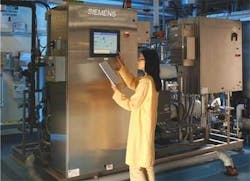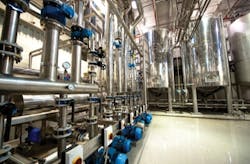| University of Illinois at Chicago Chemical Engineering Department Head Sohail Murad and UIC Dean of Engineering Peter Nelson joined Metropolitan Water Reclamation District of Greater Chicago Commissioners in unveiling a new "sewerthermal" heating and cooling system at the James C. Kirie Water Reclamation Plant in Des Plaines, IL. |
The Chicago project will compare open and closed loop systems, looking at both efficiency and maintenance requirements over the next year. The closed system circulates treated water in a closed system suspended in a long effluent channel that runs to a receiving stream for discharge. In the open system, treated wastewater is pumped from the effluent channel and then back after passing through the heat pump system.
Catherine O'Connor, Assistant Director in Monitoring and Research at MWRD, said researchers expect the open system to be more efficient and require less energy, but it might have higher maintenance needs.
"We anticipate there will be some algae growth with the open system and want to insure that isn't a problem. We want to understand how much maintenance that would be," she said.
A heat pump system can reduce energy consumption and corresponding emissions up to 44% compared to air-source heat pumps, and up to 72% compared to electric resistance heating with standard air-conditioning equipment, said Commissioner Frank Avila, chairman of MWRD's Board of Commissioners engineering committee during the ribbon-cutting ceremony.
"I am pleased to be here for the activation of an innovative new energy-saving heating and cooling system at this plant that we are calling ‘sewerthermal'," Avila said. "The data we collect could be used to design systems that can easily be applied at our other facilities."
The facility currently uses natural gas for heating and electricity for conventional air conditioning. The heat pump system will serve the 10,000 square foot administration building and is expected to reduce the building's heating and air conditioning costs by 50 percent, Avila said.
Philadelphia Mayor Michael A. Nutter also touted the energy savings possible using the technology.
"I am proud to say that Philadelphia is taking another groundbreaking step in becoming the greenest city in America," said Mayor Nutter. "Partnering with a Philadelphia-based company and using innovative technology, we have achieved a win-win for energy efficiency and economic development. We will be able to save on costs and energy resources at a city facility while commercializing a technology that can be used in large commercial and industrial buildings throughout the country."
O'Connor said heat pumps are a mature technology and this is simple innovation that could be adapted to any wastewater treatment plant that has relatively stable water temperatures. And, it's just one more example of the value that can be obtained from wastewater.
"We are beginning to refocus and understand that we are a resource recovery operation, not wastewater treatment and disposal," she said. "We believe we have a very rich biosolid that should be beneficially reused and we look forward to recovering phosphorus. Now we are recovering heat."
More WaterWorld Current Issue Articles
More WaterWorld Archives Issue Articles




